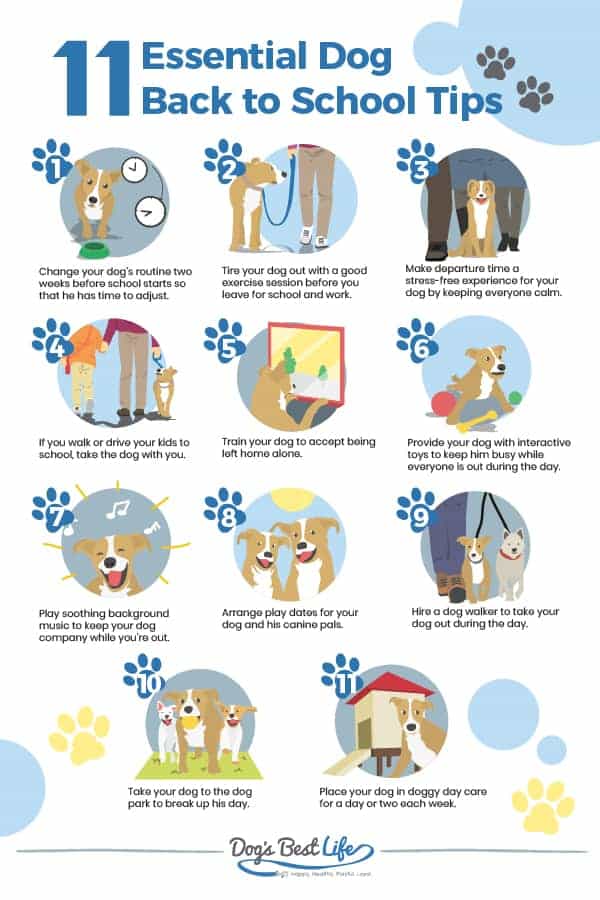
Using back-to-school tips for dogs can help make a hard adjustment period for the family pet a little easier.
After months of fun-filled days with their family, some dogs struggle to adjust when they suddenly find themselves home alone. This problem often occurs more in one-dog families.
Changes in the family’s routine can be stressful, even traumatic, to some dogs. It is not uncommon for families to get a puppy during the summer.
If you have a new puppy, it is unaccustomed to being left home alone all day and has not experienced the hectic back-to-school routine.
If so, your dog may exhibit abandonment issues and struggle to adjust to no longer having their favorite playmates with them 24/7.
Signs your dog is struggling
Depression and anxiety are two signs your puppy or dog is having difficulty coping with the new schedule.
Many display their frustration with inappropriate behaviors such as not eating, pacing, barking, whining, howling, and chewing everything in sight!
Some even regress and forget basic potty training.
Remember that when school starts, if your dog spends the day alone, their day doesn’t start until their family returns home.

Establish a back-to-school routine
Create a new schedule
Dogs feel secure when they have a familiar daily routine. We are creatures of habit, and your dog knows your habits and daily schedule.
New habits and expected routines are reassuring to your puppy or adult dog.
So, set new bedtimes and change the morning feeding routine two to three weeks before school starts.
This will help your dog adjust and your children return to a school routine.
Build-in morning exercise time
Vigorously exercise your dog as long as possible in the morning. Remember, morning is an energy-packed time in your dog’s day. After a good night’s sleep, they are ready, willing, and eager to go!
If you wear them out, they will probably want to nap for a while. A long walk or a good workout in the backyard helps take the edge off. A tired dog is a good dog!
The morning walk also provides opportunities for potty breaks.
Eliminate the drama
Don’t make departing a theatrical production. Keep it natural and low-key.
Dogs pick up on your anxiety, and that will make them more nervous. Studies show anxious or nervous owners inadvertently pass those traits to their dogs.
If dogs suffer from separation anxiety, they will be more nervous if their owners act worried about leaving them.
Dogs mimic their owners and tend to mirror stress levels.

Include the dog
Bring the dog if you walk or drive your children to and from the bus or school. This will help your puppy adjust to seeing them leave.
Your dog will learn to associate being with them on the walk or ride as fun. They also will have time to disconnect on the walk or ride home with you.
Knowing they will get to pick up the kids later will give your dog something to look forward to during the day.

Reduce separation anxiety
Get your dog used to being home alone
Before school starts, help your dog adjust to being alone by leaving them home alone for a few minutes.
Practice leaving the house for short periods and gradually increase your time away.
This can help desensitize your dog to your departure.
Slowly add a few more minutes each time they are left home alone.
Do not make a big deal about your return. You want your dog to understand that although you leave, you will return, so your departure isn’t anything to worry about.
Add playtime
Usually, most crated dogs sleep the day away. That’s boring!
Leave a few things that will occupy them. Puzzle toys can keep dogs mentally stimulated and busy.
You can also consider putting a ball or toy with your children’s scents in the dog’s crate. Your dog should find that calming.
Consider adding sound
Your dog may find it comforting to have cable TV or the radio left on when it is alone. Just hearing a human voice may be enough to help it not feel abandoned.
Another option, play music for your dog. Dogs can find loud music aggravating, so play classical music without lyrics to provide soothing background noise.
Create a safe space
Designate a specific area in the house where your dog feels safe and comfortable, such as a cozy corner with their bed and toys.
Use calming remedies
Consider using calming remedies such as pheromone diffusers or soothing music to help ease your dog’s anxiety.
Treat your dog

Set up a play date
If you have friends with dogs, they are probably going through the same thing.
Get together and arrange playdates. Dogs need dog friends!
You can do it together or even take turns watching each other’s dogs, allowing you free time to make appointments or run errands.
After even an hour or two, your dog will be happy to take a break, go home, and nap!
Get the dog out of the house
Break up your dog’s day with a trip to a dog park. Or schedule a day or three at doggie daycare.
Both options provide terrific ways to help your dog learn socialization and coping skills.
As a bonus, your dog will usually be exhausted when you arrive to take him home. Remember, a tired dog is a good dog!
Give your dog a fun surprise
Hire a dog walker or ask a retired neighbor to take your dog for a walk during the day.
Using a pet sitter will give your dog a midday bathroom break.
This will give your dog something to look forward to and break up the monotony of being alone.
Recognize signs of separation anxiety
During the back-to-school period, dogs may experience separation anxiety as their owners and family members return to their regular routines.
It’s crucial to recognize the signs of separation anxiety in dogs and address it effectively.
Start by recognizing separation anxiety:
Destructive behavior
If your dog is experiencing separation anxiety, they may engage in destructive behaviors such as chewing furniture, shoes, or other household items.
Excessive barking or howling
Dogs with separation anxiety may bark or howl excessively when left alone.
Potty accidents
Accidents indoors, even if the dog is house-trained, can be a sign of distress when left alone.
Pacing
Restlessness and constant pacing are common signs of separation anxiety in dogs.
Escape attempts
Dogs may attempt to escape confinement when experiencing separation anxiety.
Get professional help
In severe cases, consult a professional dog trainer or behaviorist to develop a comprehensive plan to address the separation anxiety.
Recognizing the signs and taking proactive measures can help your dog navigate the back-to-school transition with less stress and anxiety.
The bottom line on preparing for back-to-school
Put yourself in your puppy or dog’s place and understand their feelings.
With patience and some creativity, everyone can and will survive this annual transition period. To help your student get ready for back-to-school, buy custom essays online.

Karen A. Soukiasian owns Good Dog! — Dog Training in St. Augustine, Florida. You can follow Karen on Facebook.
